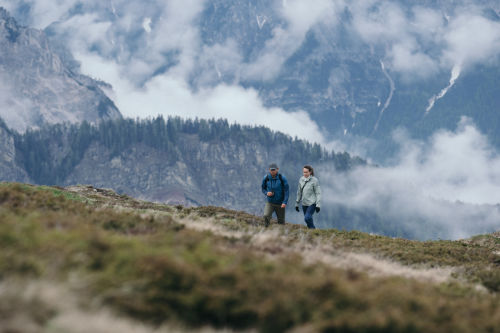Nature Explorer Jan Bjorge went to Runde bird mountain in Norway to observe puffins, gannets, razorbills, and many more. However, he also saw how human actions can impact the life of wild animals.
The travel constraints during the recent pandemic have given us all the opportunity to explore our local surroundings more. Short daytrips or weekend getaways in the region have become my way to cultivate my connection to nature.

Runde island,
Norway
If you ever find yourself on the Norwegian west coast in the Aalesund region, then take a daytrip to the famous island of Runde in the Herøy commune – or even better: spend a weekend there. You can reach the island either by boat or by car. It is only a short ferry ride and a couple of hours drive through the scenic Norwegian fjords before you arrive at the foot of the Runde mountain. In less than an hour, you can hike up the hill and arrive at the famous bird mountain. It is the largest bird mountain in southern Norway with 230+ species recorded on the island. During the nesting season, you will encounter more than 500,000 birds here. The most abundant and iconic species is the Atlantic puffin or “Lundefugl” as it is called in Norwegian.
Puffins in abundance
From April to August, puffins are nesting in the mountain’s small caves. During the winter season, they migrate to the Atlantic Ocean for food. Every summer evening at around 8 pm, thousands of puffins return to their nests on Runde mountain with mouthfuls of herring to feed their newly hatched pufflings. Their evening return is a spectacular sight that widely attracts nature enthusiasts and photographers looking to capture the magic. Currently, the conservation status of the Atlantic puffin is considered vulnerable as climate change and overfishing is drastically affecting their reproductivity.




The bird mountain’s
treasures
Other fascinating bird species that you can observe in this perfectly balanced ecosystem are:
razorbills,
guillemots,
great skua,
northern gannets,
and predator birds such as white-tailed eagles,
golden eagles,
goshawks,
and merlins which patrol the area for easy prey.


Gannets – the puffins‘ neighbors
The evening return of the puffins can be witnessed on the west side of the mountain in Lundeura, while in the north-west you will find a colony of about five thousand pairs of northern gannets. They colonize the cliffs at Rundebranden and build their nests on the steep mountain sides. The beautiful northern gannet is a close relative of the pelican and can reach an age of up to forty years. You can watch them in their nests from a distance – either from the side if you position yourself on one of the surrounding cliffs or from below if you approach by boat.



The bigger picture – seeing the human impact up close
At first sight, the habitat of the gannet is a picturesque mountain scenery like no other. Thousands of birds nesting on vertical cliffs just above the crushing waves. However, if you take a closer look with your binoculars you will also see a different and darker side to the story.
Plastic nests as deadly traps
Normally the gannets would build their nests out of seaweed and grass from the ocean and shores. However, local nature conservationists have seen an increasing amount of plastic stemming from floating garbage and fishing nets being used in the construction of gannet nests since the 1960s. This human-made impact is potentially causing fatal outcomes for the birds as the entangled gannets here photographed demonstrate.


Deep insights thanks to binoculars
Looking closer can give us the opportunity to see the bigger picture of how our waste is affecting the ocean and wildlife and what kind of damage it is causing. The plastic-built bird nests at Runde are only one of many symptoms you can see in nature. For me, they are yet another strong sign that we need to come together and tackle the growing global challenge of ocean pollution. Today, more than 8 million tons of plastic are dumped into the ocean every year. In Europe alone, 11,000 tons of fishing nets and gear are lost at sea each year – this needs to stop.

See nature’s beauty –
and understand the need to protect it
In other words, a visit to Runde bird mountain will allow you to witness the essence of nature’s beauty and fragility. And I hope that you will also see why it is so important that we study, reflect, and understand, to be able to act, preserve, and protect our precious nature and wildlife.

About the author:
Jan A. Dyreholt Bjørge
Jan grew up on the Norwegian west coast between steep mountains and deep fjords on an island called Ellingsøy. There, he discovered his passion for photography and found inspiration in capturing wildlife as well as natural sceneries. The aim of his photography is to fascinate people by showing them powerful landscapes or wild animals. By doing so, he hopes to engage as many as possible in conservation and sustainability. His pictures have been hung on walls in homes, offices, and hotels, were published in online and print magazines, won competitions, and are adorning the covers of several music albums.
Being part of the SWAROVSKI OPTIK Nature Explorers Team, Jan studies nature and wild animals closer through the CL Companion binoculars.
© all images by Jan
Do you want to observe impressive wildlife and immerse yourself into nature?
Then you don't have to travel far. The most wonderful discoveries are often waiting just around the corner. We asked our Nature Explorers team about the most beautiful experiences they had in their area.
Who knows? Maybe you will discover unexpected wonders right at your doorstep on your next outdoors adventure too.


















